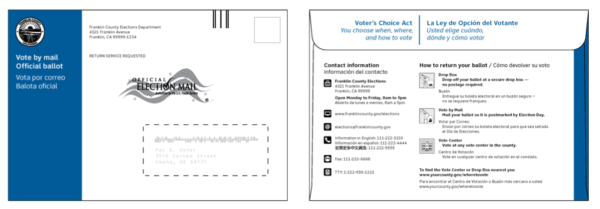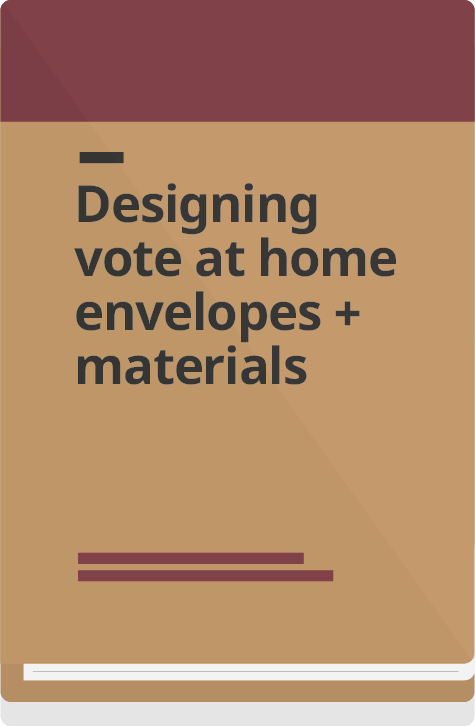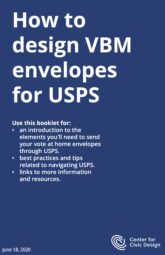Vote by mail
What if there was a national brand for voting by mail so every voter in every state can recognize their ballot when it arrives in the mail and return it successfully?
Our designs for envelopes, instructions and other materials are a simple, usable, flexible model for election administration and the US Postal Service. And our envelopes are in use in over 20 states, making dreams of a national brand for vote by mail, closer to reality.
Whether it’s called absentee voting or vote-by-mail, a successful design makes it easier for voters, affordable and robust for election administrators, and accurate for the US Postal Service. Strong vote by mail materials also:
- Makes it easier for voters to recognize and return their ballots successfully
- Supports bilingual language access requirements
- Improves election administration by reducing errors
- Uses colors to identify the type of envelope
- Is recognizable and consistent for statewide voter education campaigns
- Designed to US Postal Service requirements

The blue bar, county seal, election mail logo, and the words “Official ballot” identify the outgoing envelopes. Contact information and basic instructions on the back, with room for two languages.

The return envelopes include instructions, the voter’s signature form, and a checklist
This layout, for a 6×9″ envelope, will also fit two languages for bilingual counties.
Tools
Presentations
Vote at home webinars for election officials
National Vote at Home Institute, Center for Tech and Civic Life, and Center for Civic Design (February 2020)
Topics covered (links to slides):
- Implementing envelope best practices
- Preparing helpful supplementary materials
- Integrating low-cost tracking and reporting tools
Scaling Up in 2020: Decisions and policies needed for the 2020 elections
Center for Civic Design (March 24, 2020)
Managing mail ballot request forms
Center for Tech and Civic Life, Center for Civic Design, and ideas42 (June 11, 2020)
Our work
Research: Return ballot design analysis from Washington state
What are the design elements that make a ballot most likely to be rejected? In September 2023, we conducted an analysis of 15 return envelopes with the lowest challenge rates in Washington to find out if there are any commonalities to the layouts with the fewest rejections.
Research: Making ballot envelopes clear and understandable
As part of the process of voting by mail, voters sign a legal statement that often has complicated language and a confusing layout. We reviewed the information and signature forms on mail-in ballot envelopes from 26 states and identified strategies that election administrators can follow to make their ballot envelopes more accessible to voters.
Research: Designing ballot cure forms that invite voters to act
Hundreds of thousands of mail-in ballots can be rejected because of mistakes, such as mismatched or missing signatures. Voters are often notified by their local elections office, but are they actually taking action? In 2020, we tested 6 existing cure forms and identified 4 recommendations.
- Report: Designing ballot cure forms that invite voters to act
- Discover communication tips for helping voters cure a problem with their write-in or vote by mail ballot in An invitation to certainty, in an uncertain time
- See a sample of a letter or email, phone script, or text message to customize
Research: Making ballot envelopes clear and understandable: The impact of plain language on voter signature forms
An analysis of the readability of the voter signature forms on mail ballot envelopes and a process for making them easier to understand.
- Report: Making ballot envelopes clear and understandable
- Discover 3 strategies to improve vote-by-mail signature forms
Example: Absentee ballot instructions in Minnesota
The Minnesota Secretary of State revised their vote by mail instructions and envelopes in 2015 and 2016. See before and after versions.
Example: Instructions on vote by mail ballots build confidence in Arapahoe County, CO
In 2016, Arapahoe County, CO used trial and error to finesse the instructions on a vote by mail ballot in order to get voters to remove ballot stubs before returning their vote by mail ballots. Through plain language and including not just what to do but why, the office was able to greatly reduce the time it took to process income ballots.
Example: Counting more absentee ballots in Escambia County, FL
- Read more in Designing a Better Ballot: Even small tweaks can have a significant effect on an election by Adrienne LaFrance. The Atlantic, October 5, 2016
Other resources
COVID-19 Webinars for Election Officials. A series of 12 free webinars from Center for Tech and Civic Life. Vote by mail topics include:
- Educating voters about their options
- Managing mail ballot request forms
- Organizing ballot dropoff locations
- Streamlining the inbound ballot process
- Verifying and curing signatures
Healthy + Elections. Resources for running polling places and drop-box collection, including sample pollworker training for COVID-19 from the Stanford-MIT Healthy Elections Project.
National Vote at Home Institute’s Resource Library: Reports, briefs, and other up to date resources on the current status of the vote-at-home movement from the National Vote at Home Institute.
EAC webinars on voting by mail: A series of video conversations with election officials about the resources and approaches to scaling-up vote by mail to ensure mail ballots get cast and counted.
CCD’s work on vote by mail was made possible through support from the Democracy Fund, the Hewlett foundation, the James Irvine Foundation, Future of California Elections, and others.



